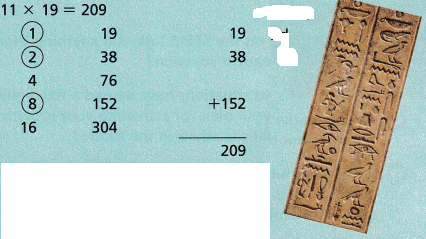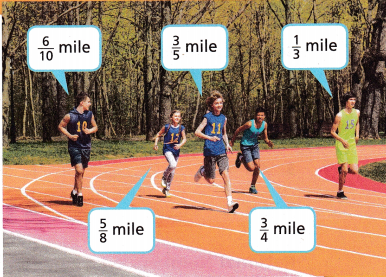We included HMH Into Math Grade 8 Answer Key PDF Module 10 Real Numbers to make students experts in learning maths.
HMH Into Math Grade 8 Module 10 Answer Key Real Numbers
Real Numbers and the Pythagorean Theorem

Historian
We know that the pyramids of Egypt were built about 5000 years ago and that the people who built them used math to do so. But how do we know? Our knowledge is largely due to historians, who study the people, events, and ideas of the past and their influence on todays world. Historians use the information they gather to develop theories and draw conclusions about their subjects.
STEM Task:
An ancient Egyptian multiplication method based on doubling is used below to find 11 × 19. Use the method to find 13 × 24.

Answer:
13 X 24 = 312,
1 13 13,
2 26 26,
4 52 52,
8 104 104
16 208 +208
312
32 416 416
Explanation:
The term that we use with Egyptian Multiplication is called Doubling.
We take one number and either multiply it by 2 or you add it to itself.
This is done repeatedly until you get the other number. We continue doubling both columns the same way until we reach but not exceed the number at the top of the first column.
Therefore as shown above 13 X 24 is 104 + 208 = 312.
Learning Mindset Resilience Manages the Learning Process

Resilience is the ability to “bounce back” after experiencing a disappointment or a defeat. When you encounter difficulty or setbacks, watch out for a fixed-mindset voice in your head telling you to give up. Here are some statements you can tell yourself to activate your growth-mindset voice and strengthen your resilience. Can you think of others?
- Mistakes and challenges are opportunities to learn.
- If this were easy, I would not learn anything from it.
- I have overcome challenges in the past, so I know I can do it again.
- When I solve this problem, I can be proud because it is not easy.
- I may be struggling, but I am still making progress.
Reflect
Question 1.
As you worked on the STEM Task, did anything trigger a fixed-mindset voice in your head? If so, what?
Answer:
Yes,
Explanation:
Identifying my fixed mindset triggers as having to work hard. Most people like to say they’re hard workers, Facing setbacks. Life happens, Getting negative feedback.
We don’t all handle critique the same way, Being challenged seeing success in others.
Question 2.
In the past, what situations have caused a fixed-mindset response in your head? What is your plan for activating your growth mindset when you encounter similar situations in the future?
Answer:
Causes to have fixed mind set:
Avoiding challenges, Giving up easily feel threatened by the success of others,
Avoid new experiences with fear of failure,
Growth mindset:
Embrace challenges,
Persevere in the face of failures and setbacks, Find inspiration in others success,
Accept criticism as a way to learn Embrace novelty with a desire to master new skills ,
Looking for people who challenge us to grow,
Explanation:
Causes to have fixed mind set:
Avoiding challenges, Giving up easily Feel threatened by the success of others,
Avoid new experiences with fear of failure Our mind plays a very powerful role in what we believe and how we think. What we think about ourselves and our abilities decides how we act and lead our life.
Believe in intelligence and talents can be developed over time.
Growth mindset:
Embrace challenges, Persevere in the face of failures and setbacks ,
Find inspiration in others success, Accept criticism as a way to learn,
Embrace novelty with a desire to master new skills, Looking for people who challenge us to grow.
Track the Distance
A group of five friends went running at the school track. They ran the distances shown.

Use the clues to determine which friend ran each distance.
- Ara and Tyrone ran the same distance.
- Morgan’s distance written as a decimal has 3 nonzero digits.
- Shane’s distance ¡n miles is equal to a repeating decimal.
- Julius ran the greatest distance.
- Tyrone’s distance in miles is given as a fraction in simplest form.
Ara ran ___________ mile.
Shane ran ___________ mile.
Tyrone ran ___________ mile.
Morgan ran ___________ mile.
Julius ran ___________mile.
Answer:
Ara ran \(\frac{6}{10}\) mile, Shane ran \(\frac{1}{3}\) mile,
Tyrone ran \(\frac{3}{5}\) mile, Morgan ran \(\frac{5}{8}\) mile,
Julius ran \(\frac{3}{4}\) mile,
Explanation:
Given group of five friends went running at the school track.
They ran the distances shown we have \(\frac{6}{10}\) = 0.6,
\(\frac{5}{8}\) = 0.625, \(\frac{3}{5}\) = 0.6,
\(\frac{3}{4}\) = 0.75, \(\frac{1}{3}\) = 0.333333,
Using the clues to determine which friend ran each distance.
1. Ara and Tyrone ran the same distance so we have \(\frac{6}{10}\) and \(\frac{3}{5}\) and we have 5. Tyrone’s distance in miles is given as a fraction in simplest form
so we have the simplest form is also called the reduced form of fraction.
The simplest form of a fraction that has a common factor equal to 1,
we have \(\frac{3}{5}\), Ara ran \(\frac{6}{10}\) mile,
Tyrone’s ran \(\frac{3}{5}\) mile, 2. Morgan’s distance written as a decimal has 3 nonzero digits we have \(\frac{5}{8}\) = 0.625, 3. Shane’s distance in miles is equal to a repeating decimal we have \(\frac{1}{3}\) = 0.333333,
4. Julius ran the greatest distance we have is \(\frac{3}{4}\) = 0.75.
Turn and Talk
Another friend, Knox, ran farther than Shane but not as far as Tyrone. What possible distance could Knox have run? Explain.
Answer:
Distance could Knox have run is in between greater than \(\frac{1}{3}\) mile and less than \(\frac{3}{5}\) can be \(\frac{1}{2}\),
Explanation
Given another friend, Knox, ran farther than Shane but not as far as Tyrone.
The possible distance could Knox have run will be as we have Shane ran \(\frac{1}{3}\) mile and Tyrone ran \(\frac{3}{5}\) mile between more than \(\frac{1}{3}\) mile and less than \(\frac{3}{5}\) so it can be \(\frac{1}{2}\).
Are You Ready?
Complete these problems to review prior concepts and skills you will need for this module.
Solve One-Step Equations
Solve each equation.
Question 1.
x + 5 = 25 ___________
Answer:
x = 20,
Explanation:
Given x + 5 = 25, solving as x = 25 – 5 = 20.
Question 2.
x + 4 = 7 ___________
Answer:
x = 3,
Explanation:
Given x + 4 = 7, solving as x = 7 – 4 = 3.
Question 3.
x – 3 = 7 ___________
Answer:
x = 10,
Explanation:
Given x – 3 = 7, solving as x = 7 – 3 = 4.
Question 4.
x – 2 = 6 ___________
Answer:
x = 8,
Explanation:
Given x – 2 = 6, solving as x = 6 – 2 = 4.
Question 5.
19x = 76 ___________
Answer:
x = 4,
Explanation:
Given 19x = 76, solving as x = \(\frac{76}{19}\) = 4.
Question 6.
5x = 70 ___________
Answer:
x = 14,
Explanation:
Given 5x = 70, solving as x = \(\frac{70}{5}\) = 14.
Question 7.
\(\frac{x}{4}\) = 12 ___________
Answer:
x = 48,
Explanation:
Given \(\frac{x}{4}\) = 12, solving as x = 12 X 4 = 48.
Question 8.
\(\frac{x}{3}\) = 8 ___________
Answer:
x = 24,
Explanation:
Given \(\frac{x}{3}\) = 8, solving as x = 8 X 3 = 24.
Rational Numbers on a Number Line
Plot each rational number on the number line.

Question 9.
0.75
Answer:

Explanation:
Plotted given 0.75 rational number on the number line as shown above.
Question 10.
–\(\frac{5}{8}\)
Answer:

Explanation:
Plotted given –\(\frac{5}{8}\) = -0.625 rational number on the number line as shown above.
Question 11.
-1.5
Answer:

Explanation:
Plotted given -1.5 rational number on the number line as shown above.
Question 12.
1\(\frac{1}{8}\)
Answer:

Explanation:
Plotted given 1\(\frac{1}{8}\) = \(\frac{9}{8}\) = 1.125
rational number on the number line as shown above.
Convert Fractions to Decimals
Question 13.
How can you convert a fraction to a decimal?
Answer:
In a fraction, the fraction bar means “divided by”, Divide the numerator by the denominator,
Explanation:
The steps to convert a fraction to decimal are given below:
Step 1: Divide the numerator by the denominator.
Step 2: Stop the division process when we get 0 in the
remainder or three decimal places in the quotient.
Step 3: The value obtained in the quotient will be our final answer in decimals.
Write each fraction as a decimal.
Question 14.
\(\frac{4}{5}\)
Answer:
0.8,
Explanation:
Given fraction \(\frac{4}{5}\) as a decimal is 0.8.
Question 15.
\(\frac{3}{8}\)
Answer:
0.375,
Explanation:
Given fraction \(\frac{3}{8}\) as a decimal is 0.375.
Question 16.
\(\frac{11}{20}\)
Answer:
0.55,
Explanation:
Given fraction \(\frac{11}{20}\) as a decimal is 0.55.
Question 17.
\(\frac{3}{4}\)
Answer:
0.75,
Explanation:
Given fraction \(\frac{3}{4}\) as a decimal is 0.75.
Question 18.
\(\frac{1}{16}\)
Answer:
0.0625,
Explanation:
Given fraction \(\frac{1}{16}\) as a decimal is 0.0625.
Question 19.
\(\frac{13}{25}\)
Answer:
0.52,
Explanation:
Given fraction \(\frac{13}{25}\) as a decimal is 0.52.